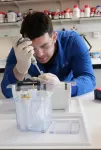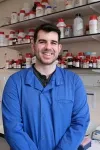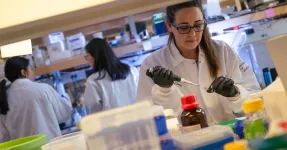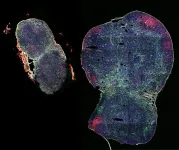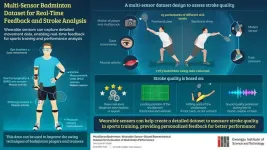(Press-News.org) Researchers have developed a new vaccine technology that has been shown in mice to provide protection against a broad range of coronaviruses with potential for future disease outbreaks - including ones we don’t even know about.
This is a new approach to vaccine development called ‘proactive vaccinology’, where scientists build a vaccine before the disease-causing pathogen even emerges.
The new vaccine works by training the body’s immune system to recognise specific regions of eight different coronaviruses, including SARS-CoV-1, SARS-CoV-2, and several that are currently circulating in bats and have potential to jump to humans and cause a pandemic.
Key to its effectiveness is that the specific virus regions the vaccine targets also appear in many related coronaviruses. By training the immune system to attack these regions, it gives protection against other coronaviruses not represented in the vaccine – including ones that haven’t even been identified yet.
For example, the new vaccine does not include the SARS-CoV-1 coronavirus, which caused the 2003 SARS outbreak, yet it still induces an immune response to that virus.
“Our focus is to create a vaccine that will protect us against the next coronavirus pandemic, and have it ready before the pandemic has even started,” said Rory Hills, a graduate researcher in the University of Cambridge’s Department of Pharmacology and first author of the report.
He added: “We’ve created a vaccine that provides protection against a broad range of different coronaviruses – including ones we don’t even know about yet.”
The results are published today in the journal Nature Nanotechnology.
“We don’t have to wait for new coronaviruses to emerge. We know enough about coronaviruses, and different immune responses to them, that we can get going with building protective vaccines against unknown coronaviruses now,” said Professor Mark Howarth in the University of Cambridge’s Department of Pharmacology, senior author of the report.
He added: “Scientists did a great job in quickly producing an extremely effective COVID vaccine during the last pandemic, but the world still had a massive crisis with a huge number of deaths. We need to work out how we can do even better than that in the future, and a powerful component of that is starting to build the vaccines in advance.”
The new ‘Quartet Nanocage’ vaccine is based on a structure called a nanoparticle – a ball of proteins held together by incredibly strong interactions. Chains of different viral antigens are attached to this nanoparticle using a novel ‘protein superglue’. Multiple antigens are included in these chains, which trains the immune system to target specific regions shared across a broad range of coronaviruses.
This study demonstrated that the new vaccine raises a broad immune response, even in mice that were pre-immunised with SARS-CoV-2.
The new vaccine is much simpler in design than other broadly protective vaccines currently in development, which the researchers say should accelerate its route into clinical trials.
The underlying technology they have developed also has potential for use in vaccine development to protect against many other health challenges.
The work involved a collaboration between scientists at the University of Cambridge, the University of Oxford, and Caltech. It improves on previous work, by the Oxford and Caltech groups, to develop a novel all-in-one vaccine against coronavirus threats. The vaccine developed by Oxford and Caltech should enter Phase 1 clinical trials in early 2025, but its complex nature makes it challenging to manufacture which could limit large-scale production.
Conventional vaccines include a single antigen to train the immune system to target a single specific virus. This may not protect against a diverse range of existing coronaviruses, or against pathogens that are newly emerging.
END
New vaccine effective against coronaviruses that haven’t even emerged yet
2024-05-06
ELSE PRESS RELEASES FROM THIS DATE:
Simulated chemistry: New AI platform designs tomorrow’s cancer drugs
2024-05-06
Scientists at UC San Diego have developed a machine learning algorithm to simulate the time-consuming chemistry involved in the earliest phases of drug discovery, which could significantly streamline the process and open doors for never-before-seen treatments. Identifying candidate drugs for further optimization typically involves thousands of individual experiments, but the new artificial intelligence (AI) platform could potentially give the same results in a fraction of the time. The researchers used the new tool, described in Nature Communications, to synthesize 32 new drug candidates for cancer.
The technology is part of a new but growing trend ...
Human ‘neural compass’ pinpointed in new study
2024-05-06
A pattern of brain activity that helps prevent us from getting lost has been identified in a new study, published in Nature Human Behaviour.
Researchers at the University of Birmingham and Ludwig Maximilian University of Munich have for the first time been able to pinpoint the location of an internal neural compass which the human brain uses to orientate itself in space and navigate through the environment.
The research identifies finely tuned head direction signals within the brain. The results are comparable to neural codes identified in ...
Personalized screening early in pregnancy may improve preeclampsia detection
2024-05-06
Research Highlights:
A personalized screening algorithm for preeclampsia in the first trimester of pregnancy may help clinicians better predict who is at risk for developing the condition and who may benefit from treatment with a daily, low-dose aspirin.
In this study of more than 7,000 women, the new screening method, which combined maternal history, biomarker tests and ultrasound tests, was better at identifying preeclampsia risk in than current risk factor-based guidelines.
Embargoed until 4 a.m. CT/5 a.m. ET Monday, May 6, 2024
DALLAS, May 6, 2024 — A new screening algorithm for preeclampsia combining maternal history, ...
Expanding a lymph node, boosting a vaccine
2024-05-06
Expanding a lymph node, boosting a vaccine
A biomaterial vaccine enhances and sustains lymph node expansion following vaccination, boosting anti-tumor immunity in an animal model.
By Benjamin Boettner
(BOSTON) — Each one of us has around 600 lymph nodes (LNs) – small, bean-shaped organs that house various types of blood cells and filter lymph fluid – scattered throughout our bodies. Many of us have also experienced some of our LNs to temporarily swelling during infections with viruses or other pathogens. This LN expansion and subsequent contraction can also result from vaccines injected nearby, and in fact ...
GIST-MIT CSAIL researchers develop a biomechanical dataset for badminton performance analysis
2024-05-06
In sports training, practice is the key, but being able to emulate the techniques of professional athletes can take a player’s performance to the next level. AI-based personalized sports coaching assistants can make this a reality by utilizing published datasets. With cameras and sensors strategically placed on the athlete's body, these systems can track everything, including joint movement patterns, muscle activation levels, and gaze movements.
Using this data, personalized feedback is provided on player technique, along with improvement recommendations. Athletes can access this feedback anytime, and anywhere, making these systems versatile for athletes at ...
Study sheds light on 11th century Arab-Muslim optical scientist whose work laid ground for modern-day physics
2024-05-06
Scientists from the University of Sharjah and the Warburg Institute are poring over the writings of an 11th century Arab-Muslim polymath to demonstrate their impact on the development of optical sciences and how they have fundamentally transformed the history of physics from the Middle Ages up to modern times in Europe.
Their research focuses on the legacy of al-Ḥasan Ibn al-Haytham known in Latin as “Alhazen” and particularly his most influential work titled Book of Optics, reputed in Arabic as Kitab al-Manazir and first circulated in Europe via its Latin translation dubbed ‘Perspectiva’. Ibn ...
Rethinking “socially admitted” patients
2024-05-06
Labelling vulnerable patients in hospital as “socially admitted” may prevent treatment of medical issues, according to new research in CMAJ (Canadian Medical Association Journal) https://www.cmaj.ca/lookup/doi/10.1503/cmaj.231430.
Emergency departments are the last resort for some socially vulnerable people who may not have an acute or new medical issue. They may be seeking care because of a breakdown of supports or the inability of the patient, or their family, to cope with living at home. These people are known colloquially as “social admissions,” and other labels such as “orphan patient,” “failure ...
A better way to ride a motorcycle
2024-05-06
Motorcycles are designed to accommodate the average-sized rider, leaving taller and shorter riders vulnerable to discomfort.
A new study from the University of Waterloo used software that predicted realistic motorcycle riding behaviours, considering human factors and ergonomic trade-offs. It found that shorter and taller statures require joint adjustments to achieve their preferred riding posture.
Taller riders are required to flex their ankles, knees, hips and elbows more to interact with the motorcycle properly, ...
Survey of US parents highlights need for more awareness about newborn screening, cystic fibrosis and what to do if results are abnormal
2024-05-05
A national survey led by Ann & Robert H. Lurie Children’s Hospital of Chicago found that parents have insufficient knowledge of newborn screening in general and of cystic fibrosis (CF) in particular. Researchers asked specific questions about CF based on studies showing that initial CF follow-up visits after a positive newborn screening often occur after 4 weeks of age, which is later than the recommended timeframe for best outcomes. Later follow-up is associated with worse nutrition in childhood, a predictor of long-term health in CF. Parents ...
Outcomes of children admitted to a pediatric observation unit with a psychiatric comanagement model
2024-05-05
About The Study: The findings of this study show a significantly lower pediatric emergency department length of stay and inpatient psychiatric admission rate following pediatric observation unit care and potential savings in inpatient psychiatric resources without contributing to 30-day readmission rates.
Authors: Rachel G. Kasdin, M.S., of the Icahn School of Medicine at Mount Sinai in New York, is the corresponding author.
To access the embargoed study: Visit our For The Media website at this link https://media.jamanetwork.com/
(doi:10.1001/jamapediatrics.2024.1123)
Editor’s Note: Please see the article for additional information, including other authors, ...
